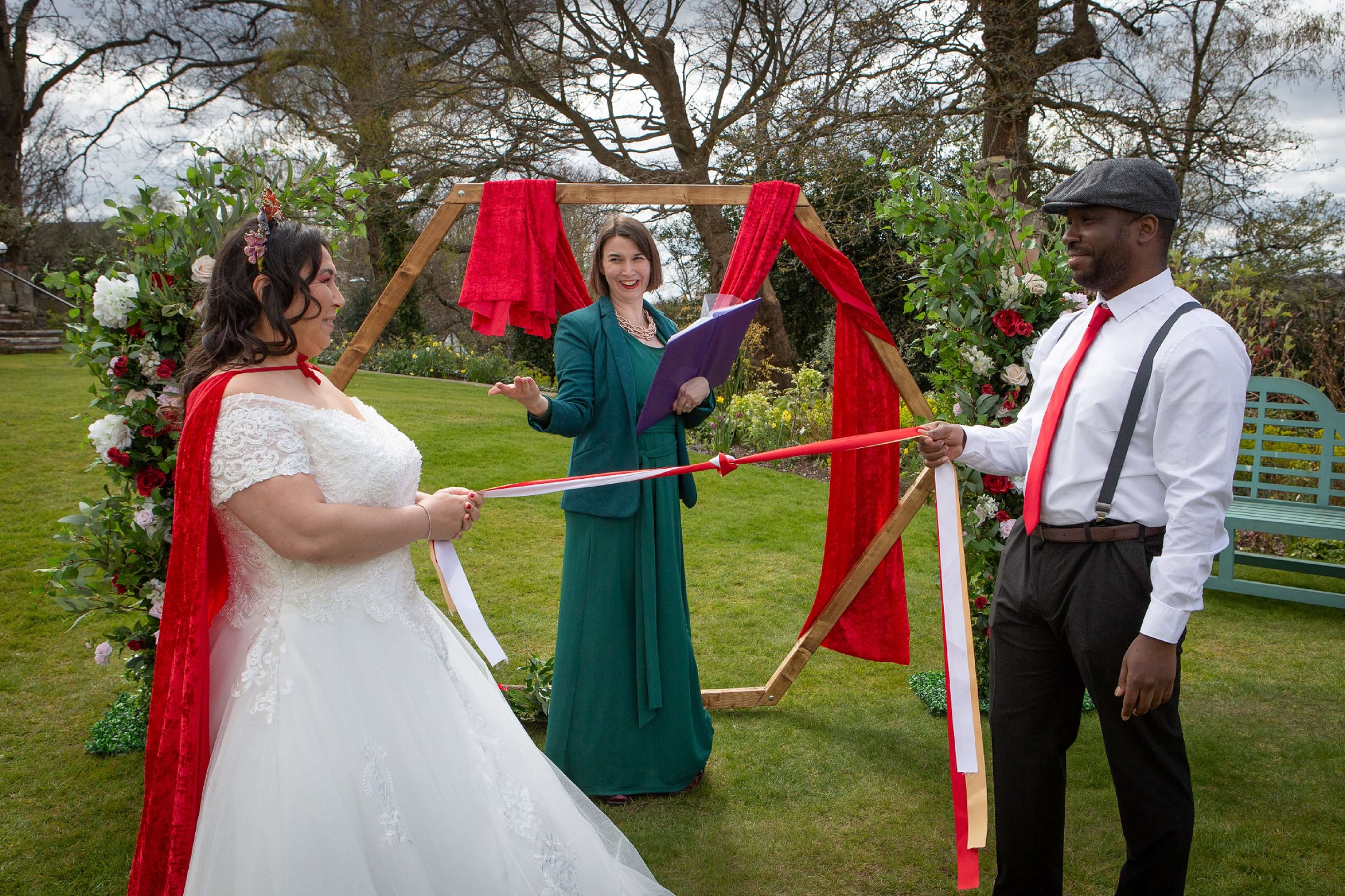What is Handfasting? How to include handfasting in a wedding ceremony
What is a Handfasting Ceremony?
Handfasting is of ancient Celtic origin and dates back to 7000 BC. Handfasting is a ceremony where the couple hold hands and two or more ribbons or cords are then gently bound around them while meaningful words or promises are spoken, before the ribbons or cords are tied into a knot. It’s thought that back in ancient Celtic tradition the handfasting ceremony was actually part of announcing a couples betrothal or intention to marry. Essentially it was the start of their engagement.
Nowadays, you’ll more often see a handfasting take place during a humanist, celebrant-led wedding ceremony. Let’s look deeper into what a handfasting is, how it works and how you could include a handfasting in your bespoke Humanist wedding ceremony.
What does a Handfasting symbolise?
There’s lovely symbolism in handfasting, much of which can still feel relevant to modern couples. The joining of hands symbolises the couple are coming together of their own free will. The ribbons symbolise the different individuals and families joining together, the knot symbolises a new family created, while still showing the individuals within, this is where the phrase ‘Tied the Knot’ came from! Of course there is also the nod to Celtic tradition.
Your wedding celebrant can write some meaningful wording to be said during the handfasting, or you might choose to say your vows or promises at the same time. Your celebrant can help you decide.
How does a Handfasting ceremony work?
When it comes to the point of your wedding ceremony for your handfasting, your celebrant will ask you to join hands. Your handfasting ribbons or cords will then be wrapped around your hands. There are lots of different ways to this and your celebrant will talk this through with you when creating your ceremony.
A knot will then be tied, again there are different ways this can happen, sometimes the wedding celebrant will do this, sometimes a particular guest and sometimes it will be tied by the couple themselves.
How many handfasting ribbons or cords should you have?
How many ribbons you have is up to you both. You need to have at least two, one for each of you. After that you can add more ribbons to represent other important people. Perhaps you want to honour your families with a ribbon each, you could have a ribbon added by your children or maybe you even want to represent your pets!
While you can have many ribbons, it does get a little long and complex once you get over six ribbons so that is a good maximum to aim for.
What material can be used in a handfasting?
Often, cords or ribbons are used. These can be yards of regular ribbon or cord available from haberdasheries or climbing shops etc that you have bought especially or you might choose
to use cloth from sentimental items of clothing. Or if you want a more organic look you could think about having garland, vines or flowers woven together by your florist to serve as your handfasting cords. Remember to ask for plants that will dry and preserve well!
How long should handfasting cords or ribbons be?
There’s no hard or fast rules on this but I find that 1 to 1 ½ metres long works best. You need enough length to easily bind and tie but you don’t need them too long and unwieldy.
Can we involve our guests in the handfasting?
Yes! Handfasting is a great way to involve a small number of guests, perhaps those who represent your wider friends or family. Ask your celebrant about how to make this work well in your particular venue and ceremony.
Can we involve our children in handfasting?
Absolutely! Involving your children in adding their own handfasting ribbon to your handfasting knot is a really beautiful way of representing you as a wider family. It’s especially lovely if you both have children, handfasting is an amazing way to reflect a blended family at your wedding.
Who actually ties the Handfasting knot?
You can decide this with your celebrant who is going to tie the handfasting knot. I think it’s particularly meaningful when the couple ties the knot themselves as it reiterates that they are choosing this path. However there are equally meaningful ways to have the knot tied either by your celebrant or by a particular guest.
**
So there you have it. A quick whistlestop tour of what a handfasting ceremony is and how you could include it in your personalised wedding ceremony.
I love handfastings, they give a really ceremonial feel to a wedding ceremony while also being a really beautiful way to involve and represent different people in your lives - and you both as a couple.
A wedding celebrant can talk you through Handfasting and lots of other wedding rituals to help you decide how to make sure you have a wedding ceremony that really reflects you both.
If you have any questions about handfasting, or if you’re ready to start planning your unique wedding ceremony with me? Drop me a line and say hello!
Thank you to Claire at Poppy K Photography for letting me share these lovely images! Find Poppy K Photography on Instagram for more!

